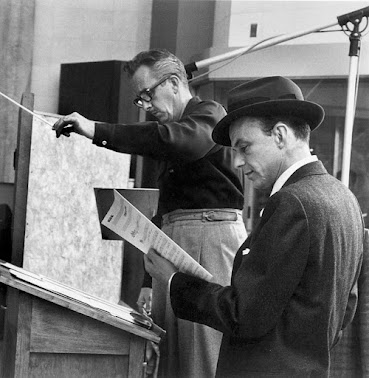Still in 1950 with "Jingle Bells," we go from the somewhat corny Dixieland of the Firehouse Five Plus Two to the straight-up corn of the Korn Kobblers!
 |
| Nels Laakso! |
 |
| Nels Laakso! |
 |
| Ward Kimball at work! |
 |
| Cover art is totally wrong! |
 |
| OTR buffs know that's (left to right) Bob Burns, Tommy Riggs, Charlie McCarthy, Edgar Bergen, Rudy Vallee and Joe Penner! |
 |
| (Maybe not the whole world!) |
The first one chronologically is from Elmer Ihrke and Skip Berg in 1949:
Pleasant enough version. Good as background music.
The flipside is "Silent Night," credited only to Elmer Ihrke:
I know Elmer was an organist and Skip Berg played celeste and they recorded a few sides for Rondo, but otherwise I haven't been able to dig up much information on either, but Elmer did get his picture on one album:
So, we kind of know what he looked like!
Much more famous was Rondo's premiere artist, organist Ken Griffin, heard on this record from (I think) 1949:
And here's the flipside:
Those are pleasant but not remarkable, but they are representative of Ken Griffin's style and he was very popular!
His popularity was really based on one/sort-of-two records...
Ken had recorded an instrumental version of a German song under the English title of "You Can't Be True, Dear" in 1948:
Again, pleasant enough, but it had something going for it, as it was big!
Rondo also released that same recording with a vocal by Jerry Wayne overdubbed:
Both of these records were huge hits, with the vocal version hitting number one while the instrumental version parked at number two!
They're both soooooo square, even by 1948 standards, but, boy, they were popular!
Even more fascinating is the little disclaimer on the record label!
There's even more in these "Billboard" ads:
I think it was based on a dispute over royalties between the original German publisher and Biltmore Music Corp, the American representative.
Whatever the case, Ken Griffin was able to successfully ride the wave of popularity with several later releases on Columbia Records until his untimely passing in 1956.
As we continue with "Jingle Bells," we find ourselves in 1947 with a couple of instrumentals from musicians with the surname Smith!
 |
| Johnny Mercer (left) with Capitol Records co-founders Glenn Wallichs and B.G. DeSylva |
 |
| June Hutton with the Pied Pipers |
 |
| The Mrs. is really her! |
We leave the singing cowboys and their "Jingle Bells" to meet up with a very un-cowboy singer - one Francis Albert Sinatra!
 |
| Frank seems more amused than Axel! |
 |
| Frank checks the lyrics while Gordon Jenkins conducts. |